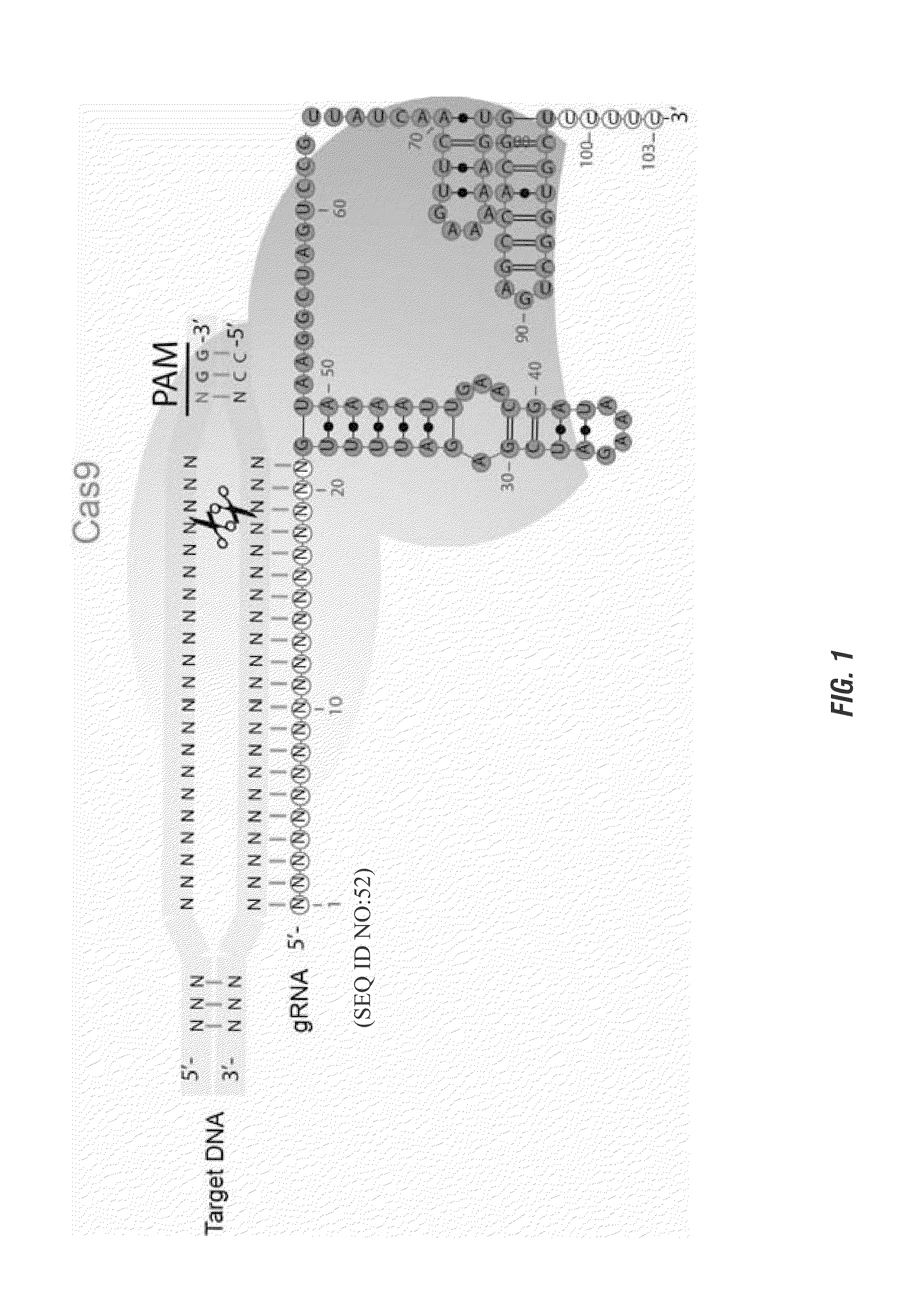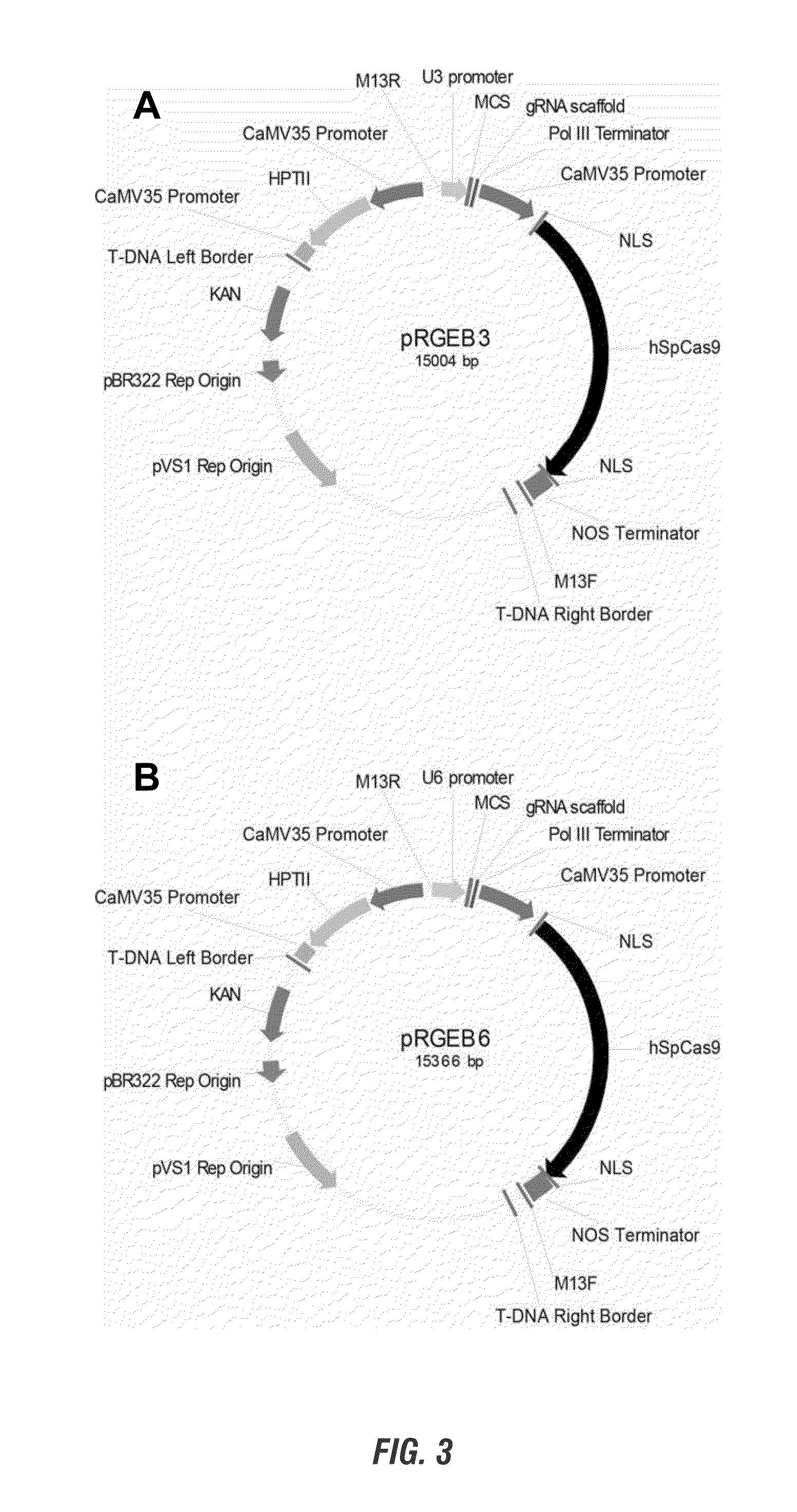Gene targeting and genetic modification of plants via rna-guided genome editing
a technology of genome editing and plant gene targeting, applied in the field of molecular biology and genetic engineering, can solve the problems of difficult to achieve successful gene targeting in plants, tedious and time-consuming screen and identify desirable zfn, and achieve the effect of reducing the off-targeting of the crispr-cas system
- Summary
- Abstract
- Description
- Claims
- Application Information
AI Technical Summary
Benefits of technology
Problems solved by technology
Method used
Image
Examples
example i
Targeted Mutation of a Mitogen-Activated Protein (MAP) Kinase Gene in Rice
[0123]Precise and straightforward methods to edit the plant genome are much needed for functional genomics and crop improvement. The inventors herein provide compositions and methods for genome editing and targeted gene mutation in plants via the CRISPR-Cas9 system. Three guide RNAs (gRNAs) with a 20-22 nt seed (also referred as spacer) region were designed to pair with distinct rice genomic sites which are followed by the protospacer adjacent motif (PAM). The engineered gRNAs were shown to direct the Cas9 nuclease for precise cleavage at the desired sites and introduce mutation (insertion or deletion) by error prone non-homologous end joining DNA repairing. By analyzing the RNA-guided genome editing events, the mutation efficiency at these target sites was estimated to be 3-8%. In addition, off-target effect of an engineered gRNA-Cas9 was found on an imperfectly paired genomic site, but it had lower genome ed...
example ii
Genome Editing in Potato (a Dicot Food Crop)
[0157]The above example demonstrated how CRISPR / Cas9 technology may be adapted and applied to gene editing in monocots and cereal crops such as rice. In this example, the Inventors sought to apply the current genome editing technologies in dicot crops such as potato (Solanum tuberosum), the most important non-grain food crop of the world. The Inventors successfully employed transient expression method to deliver Cas9, along with a synthetic gRNA targeting the StAS1 gene, into potato leaf protoplasts. The expression of Cas9 or gRNA alone did not cause any mutations, and DNA sequencing confirmed that a potato asparagine synthase gene (StAS1) was mutated at the target site in transfected potato protoplasts expressing both Cas9 and gRNA. The mutation rate with the CRISPR / Cas9 system in potato protoplasts was approximately 3.6%-4.6%. This is the first demonstration of genomic editing in potato using CRISPR / Cas9 system, which will promote the st...
example iii
Targeted Mutation of AtPDS3 in Arabidopsis via the Agrobacterium tumefaciens-Mediated Transformation
[0172]To test if the gRNA-Cas9 system works in the Agrobacterium-mediated plant transformation, Two gRNAs were designed to target two distinct sites in the coding region of AtPDS3 (Accession number: NM—202816.2) which encodes the Arabidopsis phytoene dehydrogenase (FIG. 19). Plants defective in AtPDS3 display leaf bleaching phenotype, which makes it easy to examine gene knock-out efficiency. Two DNA sequences (Table 4) encoding the gRNAs were synthesized and cloned into pRGEB3 and pStGEB3, respectively.
[0173]Two sets of RGE vectors were used for targeted mutagenesis of AtPDS3 in Arabidopsis using the Agrobacterium tumafaciens-mediated floral dip method. One contains the 35S promoter-driven Cas9 and rice U3 promoter-driven gRNA in pRGEB3, while another contains the 35S promoter-driven Cas9 and Arabidopsis U3 promoter-driven gRNA in pStGEB3. Following the Agrobacterium-mediated transfor...
PUM
| Property | Measurement | Unit |
|---|---|---|
| temperature | aaaaa | aaaaa |
| pH | aaaaa | aaaaa |
| pH | aaaaa | aaaaa |
Abstract
Description
Claims
Application Information
 Login to View More
Login to View More - R&D
- Intellectual Property
- Life Sciences
- Materials
- Tech Scout
- Unparalleled Data Quality
- Higher Quality Content
- 60% Fewer Hallucinations
Browse by: Latest US Patents, China's latest patents, Technical Efficacy Thesaurus, Application Domain, Technology Topic, Popular Technical Reports.
© 2025 PatSnap. All rights reserved.Legal|Privacy policy|Modern Slavery Act Transparency Statement|Sitemap|About US| Contact US: help@patsnap.com



